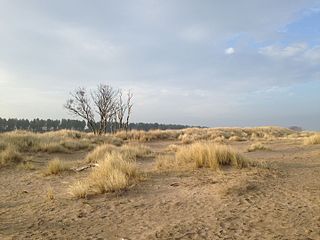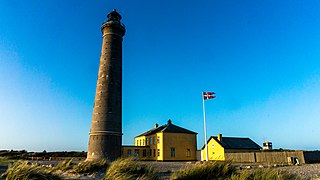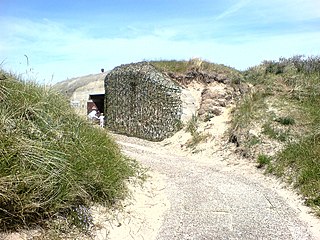
Holkham National Nature Reserve is England's largest national nature reserve (NNR). It is on the Norfolk coast between Burnham Overy Staithe and Blakeney, and is managed by Natural England with the cooperation of the Holkham Estate. Its 3,900 hectares comprise a wide range of habitats, including grazing marsh, woodland, salt marsh, sand dunes and foreshore. The reserve is part of the North Norfolk Coast Site of Special Scientific Interest, and the larger area is additionally protected through Natura 2000, Special Protection Area (SPA) and Ramsar listings, and is part of both an Area of Outstanding Natural Beauty (AONB) and a World Biosphere Reserve. Holkham NNR is important for its wintering wildfowl, especially pink-footed geese, Eurasian wigeon and brant geese, but it also has breeding waders, and attracts many migrating birds in autumn. Many scarce invertebrates and plants can be found in the dunes, and the reserve is one of the only two sites in the UK to have an antlion colony.

Skagen is Denmark's northernmost town, on the east coast of the Skagen Odde peninsula in the far north of Jutland, part of Frederikshavn Municipality in Nordjylland, 41 kilometres (25 mi) north of Frederikshavn and 108 kilometres (67 mi) northeast of Aalborg. The Port of Skagen is Denmark's main fishing port and it also has a thriving tourist industry, attracting 2 million people annually.

Studland is a village and civil parish on the Isle of Purbeck in Dorset, England. The village is located about 2 miles (3.2 km) north of the town of Swanage, over a steep chalk ridge, and 3 miles (4.8 km) south of the South East Dorset conurbation at Sandbanks, from which it is separated by Poole Harbour. The parish includes Brownsea Island within the harbour. In the 2011 census the parish had 182 households and a population of 425, though many of the houses in the village are holiday homes, second homes, or guest houses, and the village's population varies depending upon the season.

Amrum is one of the North Frisian Islands on the German North Sea coast, south of Sylt and west of Föhr. It is part of the Nordfriesland district in the federal state of Schleswig-Holstein and has approximately 2,300 inhabitants.
UNESCO Biosphere Reserves are environment-protected scientific-research institutions of international status that are created with the intent for conservation in a natural state the most typical natural complexes of biosphere, conducting background ecological monitoring, studying of the surrounding natural environment, its changes under the activity of anthropogenic factors.

Grenen is a long sandbar spit at Skagen Odde, north of the town of Skagen.

The Skagen railway line is a 39.7 km (24.7 mi) long standard gauge single track railway line between Skagen and Frederikshavn in Vendsyssel, Denmark. The railway links the fishing port and seaside resort of Skagen with the Danish rail network.

Råbjerg Mile is a migrating coastal dune between Skagen and Frederikshavn, Denmark. It is the largest moving dune in Northern Europe with an area of around 2 km2 (0.4 mi2) and a height of 40 m (130 ft) above sea level. It is also the only major stretch of migrating dunes in Denmark. The dune contains a total of 4 million m3 of sand. The wind moves it in a north-easterly direction up to 18 metres (59 ft) a year. The dune leaves a low, moist layer of sand behind it, trailing back westwards towards Skagerrak, where the Mile originally formed more than 300 years ago. Over 250,000 people visit the dune every year.

Cape Flats Sand Fynbos (CFSF), previously known as Sand Plain Fynbos, is a critically endangered vegetation type that occurs only within the city of Cape Town. Less than 1% of this unique lowland fynbos vegetation is conserved.

The Skagen Odde Nature Centre, on the northern tip of Denmark's Jutland, is a museum devoted to the effects of sand, water, wind and light. It was designed in 1989 by Jørn Utzon, the celebrated architect behind the Sydney Opera House. Under the leadership of his son Jan, the centre was completed in 2000.

The Eastern Isles are a group of twelve small uninhabited islands within the Isles of Scilly Area of Outstanding Natural Beauty, part of the Scilly Heritage Coast and a Site of Special Scientific Interest (SSSI) first designated in 1971 for its flora and fauna. They have a long period of occupation from the Bronze Age with cairns and entrance graves through to Iron Age field systems and a Roman shrine on Nornour. Before the 19th century, the islands were known by their Cornish name, which had also become the name of the largest island in the group after the submergence of the connecting lands.

At a flat coast or flat shoreline, the land descends gradually into the sea. Flat coasts can be formed either as a result of the sea advancing into gently sloping terrain or through the abrasion of loose rock. They may be basically divided into two parallel strips: the shoreface and the beach.

Wangford Warren and Carr is a 67.8-hectare (168-acre) biological Site of Special Scientific Interest between Brandon and Lakenheath in Suffolk. It is a Nature Conservation Review site, Grade I, and part of the Breckland Special Area of Conservation, and Special Protection Area An area of 15 hectares is managed as a nature reserve by the Suffolk Wildlife Trust

Tentsmuir National Nature Reserve (NNR) is located southeast of Tayport in Fife, Scotland. The reserve is made up of three parts, encompassing Morton Lochs, Tentsmuir Point and Tayport Heath, and is managed by NatureScot. The different sections of Tentsmuir NNR were originally designated as separate national nature reserves at different times: the Morton Lochs section was designated in 1952; Tentsmuir Point in 1954; and Tayport Heath in 1988. While these discrete sections are distant from one another, they form part of the extensive dune system at Tentsmuir, and in 2003 SNH combined the three sites to form Tentsmuir National Nature Reserve. The adjoining Tentsmuir Forest is managed by Forestry and Land Scotland and covers most of the land between the three portions of the NNR.

Skagen Odde, also Skagens Odde, sometimes known in English as the Scaw Spit or The Skaw, is a sandy peninsula which stretches some 30 km (19 mi) northeast and comprises the northernmost area of Vendsyssel in Jutland, Denmark.

Højen or Gammel Skagen on the west side of Skagen Odde is an old fishing community which now forms part of the town of Skagen in the far north of Jutland, Denmark. It has a permanent population of about 30.

Albæk Bugt is a shallow bay, some 20 m (66 ft) deep, off the northeast coast of Skagen Odde in the north of Jutland, Denmark. It stretches from Skagen in the north to Hirsholmene to the south. On the Kattegat side of Vendsyssel, it is frequently used as an anchorage for vessels seeking shelter from the west wind in the Skagerrak.

Skagen Lighthouse, also known as Skagen's Grey Lighthouse, is an active lighthouse four kilometres northeast of Skagen in the far north of Jutland, Denmark. Designed by architect Niels Sigfred Nebelong, it was brought into operation on 1 November 1858.

Skagen Bunker Museum is a private museum near the tip of Grenen in the far north of Jutland, Denmark. It is located in an old German bunker of the Regelbau 638 type which was used during the Second World War as an infirmary for treating wounded soldiers. It is now fitted out as a small museum with uniforms, weapons and other artifacts.

Hulsig Church is a church located in the village of Hulsig, 10 km (6.2 mi) south of Skagen in the far north of Jutland, Denmark.



















